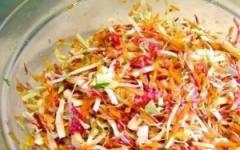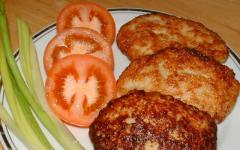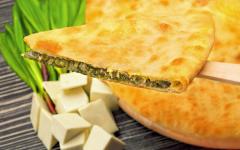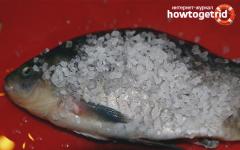In domestic culinary literature and the Internet, it is widely believed that the attribute of the New Year, the same as the Christmas tree, Santa Claus and tangerines, the dish “herring under a fur coat” is an original product of post-revolutionary Russia. They claim that in full accordance with the changes that took place in the country after the 1917 revolution, including the lack of products like grouse, pineapples and other truffles, which, apparently, were eaten by the last bourgeois, following the call of V. Mayakovsky: “Eat pineapples , grouse chew, // your last day comes, bourgeois ”, a new dish appeared in the light, in which the herring replaced sturgeon, sturgeon and other fish delights, and beet potatoes and carrots - artichokes, twill and capers, used earlier in luxury fish salads. Its name “Herring under a fur coat” allegedly reflected the desire of the new government for cuts. As a result, the abbreviation “ fur coat"From the name of fish salad, composed in the spirit of the times by the enterprising owner of the restaurant: "Chauvinism and Decline - Boycott and Anathema."
Proponents of such an extravagant explanation of the name of the common cold snack most likely do not take into account the indisputable fact that this dish appeared on the table of Soviet citizens only from the 60s of the twentieth century, when words such as chauvinism, decline, boycott and anathema were used only by teachers stories very far from cooking.
“Herring under a fur coat” was born in domestic cooking thanks to the efforts of a nameless chef who was not witty, who came up with the happy thought of not only transforming the recipes of Norwegian salads with herring, adapted to domestic products, but also giving an original, memorable name to the snack. The dish and its name "herring under a fur coat" settled down. The first is because it was tasty and easy to make from products always available in the USSR. The second is apparently due to consonance with the usual word meaning outerwear.
In the "Explanatory Dictionary of the Living Great Russian Language" by V.I. Dahl, among the meanings of the word "fur coat" there is this: "Various kinds of tires and earrings (protection - I.S.), for heat or saving something." One of the synonyms for the word "coat" in modern Russian is "cover". Probably, this explains the appearance of the bright, memorable name of this cold Russian snack to vodka, in which pieces of herring fillet are covered with layers of onion, potato, carrot and beet, just as a fur coat covers the body of its owner.
Another version of the dish originates from the Baltic Jewish towns, whose inhabitants are very respected multi-layered salad of herring, apples, beets, onions and eggs.
For those who do not believe in the origin of snacks from a country where mass herring fishing began more than a thousand years ago and in which “a true Norwegian eats herring twenty-one times a week” in the form of cold appetizers, salads, pates, soups, hot dishes pies, the author found it necessary to bring a Norwegian recipe for making herring salad and, for comparison, the most common domestic recipe for snacks, giving readers the right to please his heart to decide whether they are similar or not.
Herring Salad, Norwegian Cuisine
90 g herring fillet, 20 g apples, 2 eggs, 40 g potatoes, 10 g onions, 5 g green onions, 50 ml cream, 5 g wine vinegar, 4 g olive oil, 2 g mustard, pepper, sugar, salt.
Herring fillet cut into thin slices. Peeled apples, boiled potatoes and onions cut into small cubes. Protein of boiled eggs finely chopped. All mix gently, and pour dressing from a mixture of olive oil and cream. When serving, sprinkle the salad with finely chopped onions.
Note. The preparation of the dressing, which is nothing but a kind of mayonnaise made by own hands, is: olive oil Mix with vinegar, pureed yolk, add salt, black pepper, sugar, mustard and cream. All mix thoroughly until smooth.
Herring under a fur coat, a dish of Russian cuisine
1-2 salted herring, 2-3 boiled potatoes, 1 onion, 2-3 eggs, 1 boiled carrots, 2 boiled beets, 4 tablespoons of mayonnaise.
Separate the fillet, remove all the bones, cut into small pieces. Finely chop the onion, grind all other products. At the bottom of herringbone put onions, fish on it, then layers of potatoes, eggs, carrots, beets. Smooth a layer of beets, pour mayonnaise. Put in the fridge for 2-3 hours.
The technology of cooking herring under a fur coat in accordance with the principles of the chef, the author of culinary best-selling books I. I. Lazerson
Boil and cool the carrots, potatoes, eggs. Beets bake in foil. Clean all components. Peel the onions, finely chop, pour vinegar.
Close the bottom of a suitable-sized container with a thin layer of grated potatoes, lay out a layer of herring fillet cut in small pieces, lightly smear with mayonnaise, distribute pickled onions on the surface of the herring.
Peel the sweet and sour apple, grate directly on the surface of the onion. Grate a thick layer of potatoes on top, brush with mayonnaise, grate carrots, a little thinner than a layer of potatoes, brush with mayonnaise. Grate a layer of beets, level the mayonnaise on the surface, sprinkle with grated egg and finely chopped dill.
The author is convinced that by decorating new Year's table traditional herring under a fur coat, cooked with your own hands according to one of the recipes, dear readers in any case will enjoy the excellent taste of the snack, regardless of the country of origin of the recipe. "
Today we will continue to get acquainted with the history of the origin of famous dishes that traditionally decorate ours with you. festive table. It will be about the legendary Russian snack - “Herring under a fur coat”. By the way, few people know that “fur coat” is an abbreviation (at least, according to folk tradition), but more on that a little later, and now we will do a little excursion into the history of culinary art. So:
Herring under a fur coat was born in 1918. In this turbulent time, our people in every way sought out historical truth, and, as is well known from ancient times, the tavern was a favorite place of truth-seekers. It was in the taverns that hot debates were started with the singing of the “Internationale” on the tables, smashing dishes and mutual accusations of counterrevolution.
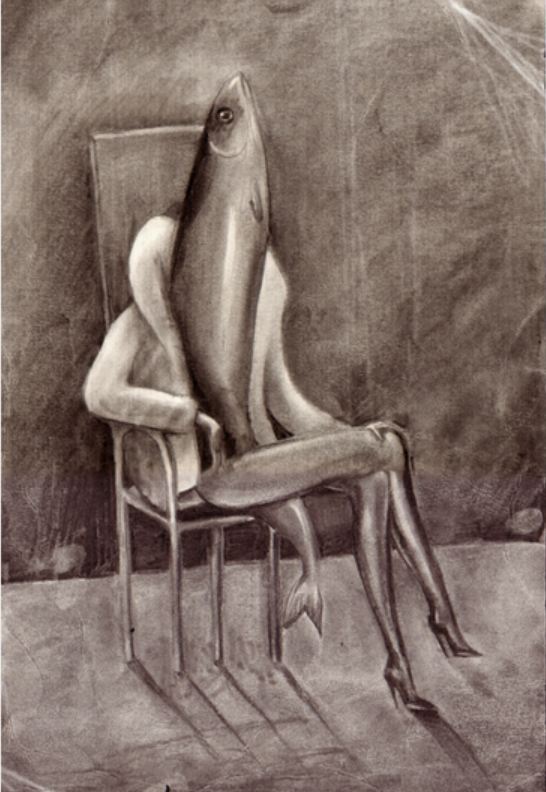 Naturally Moscow innkeepers did not like such an “unhealthy” atmosphere at all, because they had to suffer huge losses and lose their clientele. Anastas Bogomilova, the owner of a network of popular eateries, did not like this atmosphere, and he decided to find a way to avoid a civil war, at least in his own institutions.
Naturally Moscow innkeepers did not like such an “unhealthy” atmosphere at all, because they had to suffer huge losses and lose their clientele. Anastas Bogomilova, the owner of a network of popular eateries, did not like this atmosphere, and he decided to find a way to avoid a civil war, at least in his own institutions.
Anastas was rescued by one of his cooks - Aristakh Prokoptsev. Aristarchus suggested paving the way to the hearts of the rebels through the stomach.
He invented a sort of "dish of the world", each element of which carried a certain meaning: herring signified the proletariat, since it was one of his favorite foods; potatoes, carrots and onions as coming out of the ground personified the peasantry; Well, beets - the red banner of the revolution.
The salad was generously flavored with mayonnaise French sauce - either as a sign of respect for the Great French Bourgeois Revolution, or, on the contrary, as a reminder of the Bolsheviks external enemy - the Entente, which included France.
And now about the title. It was appropriate: "Chauvinism and Decline - Boycott and Anathema", and in abbreviated form - "Sh.U.B.A."
The visitors liked this salad extraordinarily - they were actively eating them, due to the fact that they got drunk less, and therefore they fought less. The “Herring under a fur coat” was presented, on the eve of the new year 1919, and since then has become a traditionally New Year's dish.

Herring under a fur coat (or simply "fur coat") is a herring and boiled vegetables salad popular in Russia and the CIS countries. Its history does not go back to antiquity, the salad was created only at the beginning of the 20th century.
According to the recipe “Herring under a fur coat”, a layer of sliced salted herring fillet cut into small pieces is laid out on a flat dish and successively covered with layers of boiled potatoes, carrots, and grated beets, layers of onions, chopped boiled eggs and green apples can also be added. It is desirable that the last layer was beet. In most recipes, mayonnaise is applied between the layers and the top. Ready salad "Herring under a fur coat" can be decorated with greens and egg slices.
The history of the salad "coat"
The history of the salad "coat" is very romantic. In 1918, a merchant, named Anastas Bogomilov, was greatly concerned with the state of his taverns in Moscow and Tver. The fact is that its visitors often got drunk, started controversies, which, as a result, flowed into fights and, as a “side effect”, after these fights, Bogomilov’s property was often found: dishes were broken, furniture was broken, windows were broken. And then one of his chefs, a certain Aristarkh Prokoptsev, came up with interesting recipe. He took the herring, which symbolizes the proletarians, added potatoes (symbolizing the peasants), blood-red beets (the color of blood and the Bolshevik banner) and French sauce Provencal. And beautifully laid out all the ingredients on the dish, smearing the sauce. In the tavern of Bogomilov, this dish was presented on the eve of the New, 1919, year. All the visitors and guests of this tavern enjoyed the snack with this unusually tasty dish, due to which they got drunk less and fought less.
At that time, the dish was named "Sh.UA.BA", which stands for "Chauvinism and Decline - Boycott and Anathema". In subsequent years, when world wars broke out, the names of Bogomilov and Prokoptsev were forgotten; her simple affordable recipe and an unusual taste has taken root among the people, becoming widespread.
How to choose a quality herring for salad
Herring under a fur coat, herring marinated with onions, and other equally popular dishes from this fish are usually present on the Christmas and New Year tables of Ukrainians. But not everyone knows how to choose the right herring for a salad in order to get a tasty and healthy dish.
At the end of the 14th century, herring was considered food worthy only of beggars. This is all because of the heavy nasty smell that herring made, as well as the vile bitter taste. All these charms happened to the herring because it spoiled even before it was taken to the shore. Revolution in the world of herring produced a fisherman Jacob Beykels, who right in the boat began to remove the gills from the herring and pour it with salt, so as not to spoil. Due to this, the herring became the favorite food of the Dutch, and a real boom of herring taste began on it.
The gills are the first and most important thing to look at when choosing a herring, says a professor at the Department of Food Hygiene at the Bogomolets National Medical University. In high-quality herring, the gills are elastic and not falling apart, they are dark red in color. If the gills are herring brown color, then, most likely, its storage period has long expired. You also need to pay attention to the smell of gills. It should not be bitter or rotten. This means that the fish were stale or stored incorrectly.
Salted herring is of three degrees of salting: weak, medium and strong salted. If you like unsalted, choose a herring with red eyes. Herring with red eyes usually has a higher fat content. Herring with dull eyes is most likely a fish with caviar. All her vitality during the spawning period was spent on the production of eggs. This fish is also not very fat. She spent her fat on a lot of movement.
To choose the right herring, pay attention to the meat. Quality herring has elastic meat, says a nutritionist-endocrinologist at the Kiev Medical Diagnostic Center. You will feel this elasticity when you press your finger on the carcass. On the skin of high-quality herring should not be visible yellow or brown traces similar to rust. Their presence indicates improper storage conditions.
Also on the carcass of high-quality herring there should be no abrasions, cracks and cuts: they indicate that the fish was kept in salt and stored at a temperature higher than necessary. A white coating on the skin of the herring indicates that low-quality salt with harmful impurities was added to it. It is possible to determine the individual sex by the roundness of the mouth. Round mouth - female, which, most likely, will also have caviar. Stretched narrow - male. Males, according to lovers, fatter and tastier than females.
Once was not tastier dishesthan srednesoleny barrel herring. Now such a fish is a rarity. And yet it can be sold from large containers. There herring swims in brine. If the pickle is unclear, it does not smell good - go to choose another herring. If the brine is transparent, you can start other signs of recognizing the quality of the herring.
Interesting facts about "Herring under a fur coat"
On the last Herring Day in Kaliningrad, all the guests of the holiday tried the record “Herring under a fur coat”. Indeed, "Herring under a fur coat", prepared on April 10 at the Museum of the World Ocean, went down in history. The museum received official congratulations from the editor of the Book of Records of Russia. He said that the Kaliningrad chefs dish was awarded the title of “The largest salad in the Russian Federation”.
The weight of this salad "Herring under a fur coat" was 488 kg, length - 12 meters was recorded by independent witnesses of a special commission. 50 kg of herring, 98 kg of beets, 94 kg of carrots, 158 kg of potatoes, 720 eggs, 50 kg of mayonnaise were spent on making a record dish.
Legendary new Year's Dish with political overtones. It appeared in the crucial year of 1918 and reconciled the proletariat with the peasantry. By the way, few people know that "fur coat" is an abbreviation. At least, if you believe the folk legend.
According to legend, this "Venus in Furs" was born in 1918. In this, to put it mildly, not very quiet time, the people in every way sought out the historical truth. Ever since Dostoevsky's time, the inn was the favorite place of truth-seekers — it was there that the most heated disputes were started: with smashing dishes, accusations of counterrevolution and singing the Internationale on the tables. One of the Moscow merchants, the owner of a network of popular eateries, Anastas Bogomilov, did not like this kind of “unhealthy” atmosphere, and he was looking for a way to avoid a civil war at least in his own establishments.
To help Anastas came one of his chefs - Aristarkh Prokoptsev, who offered to pave the way to the hearts of the rebels through the stomach. He invented the “dish of the world”, each ingredient of which was symbolic: it signified the proletariat, since it was one of his favorite foods; potatoes, carrots and onions - as coming out of the ground - personified the peasantry; and - the red banner of the revolution. The salad was generously flavored with mayonnaise French sauce - either as a sign of respect for the creators of the Great French Bourgeois Revolution, or, on the contrary, as a reminder of the Bolsheviks external enemy - the Entente, which included France. The name of the dish was appropriate: “Chauvinism and Decline - Boycott and Anathema”, and in abbreviated form - “Sh.U.B.A.”. the visitors liked this one extraordinarily: they were actively snacking on them, in connection with which they got less drunk and, accordingly, less fought. And the “fur coat” was presented just on the eve of New, 1919.
It is not known how true this legend is, but its originators were people, of course, talented: not only did they "award" herring under a fur coat with hidden meaning, they also found an excuse for its New Year's status.
Playing classics
The ingredients of traditional herring under a fur coat are known to everyone: herring, potatoes, carrots, onions, apples, beets, mayonnaise. Vegetables (except onions) must be boiled, but the apple must be raw. It is better to take a large bow - it is sweeter. And mayonnaise - with a large percentage of fat or homemade.
Recipe. Herring under a fur coat
Ingredients: 300 g herring fillet, 300 g beets, 300 g carrots, 300 g potatoes, 300 g apples, 150 g onions, mayonnaise.
CookingBoil potatoes, carrots and beets in a uniform until ready. Cool, peel and grate on a fine grater in different plates. Finely chop the onion. Herring fillet cut into small pieces. Apple peel, grate on a medium grater. Lay all the ingredients (layers, smear with mayonnaise) on the bottom of a flat salad bowl: potatoes, herring, onions, carrots, apples, beets.
Despite open access to classic recipe, everyone prepares this salad in his own way: someone ignores onions, someone replaces an apple with pickled cucumber, and someone adds cheese to everything else. And this is not the limit! Modernity is not famous for its reverent attitude to the classics, and it does not matter - this is Pushkin or just a herring under a fur coat. There are innovators who dare to make major changes to the legendary recipe. Many chefs politely offer herring to "move over" and make way for more noble and gourmet fish (salmon, salmon) or seafood (shrimp, crab, squid). But the housewives themselves arrange a real revolution: they confidently invade the recipe, and as a result such salads appear on the tables, such as “Herring under a fur coat without herring”, “Herring under a fur coat with eggs”, “Herring in a new fur coat”, “Herring in a coat "," Herring under a light fur coat "," Herring in a sheepskin "...
There is even a vegetarian (even vegan) version of the salad - “Sea under a fur coat”. Herring is replaced or algae, for example, wakame. According to strict vegetarians, the real fishy taste of these algae perfectly fills the taste of the herring itself. For the “density”, some add pickled mushrooms to the algae. And eggs, which are not and cannot be in the classic “fur coat”, but which most often appear in the “average”, are replaced by vegans with avocados. Mayonnaise is used vegetable, without eggs. At one of the popular vegetarian forums, a visitor, having learned of the existence of the “Sea under a fur coat”, left a touching comment: “Surprisingly, in five years of veganism, I did not suffer from meat at all. The only thing I really wanted was tears from herring under a fur coat ... Now I know how to console myself. ”
The main culinary tradition in Russia is not to change the taste of childhood. Here, in the Soviet Union there was a shortage of products. So, the mistress of banal potatoes, beets and forever affordable herring made a festive dish. Well, now what? There are dozens of fish in stores. Fruits and vegetables overseas (but not European or non-Turkish - this is taboo). Many sauces. And we are still every New Year prepare the simplest "coat". And no to you caprese or, forgive, my God, Nisuaz. Who invented this truly popular recipe? And imposed on us love on the verge of dependence.
I take off my hat in front of the TV channel “Moscow-Trust” and the leading Irina Shikhman because with our help they exposed this bike about the herring under a fur coat. Basically, I guess who launched it in the media a decade ago. However, then it was only an innocent journalistic joke, a joke - no more. Who knew that they would take it seriously and begin to replicate it in all the newspapers and on TV.
The tale about the fact that for the first time the innkeeper Anastas Bogomilov prepared herring under a fur coat after the revolution, bypassed all the culinary pages of the Internet. I will say right away - this is a fictional bike, and nothing more.
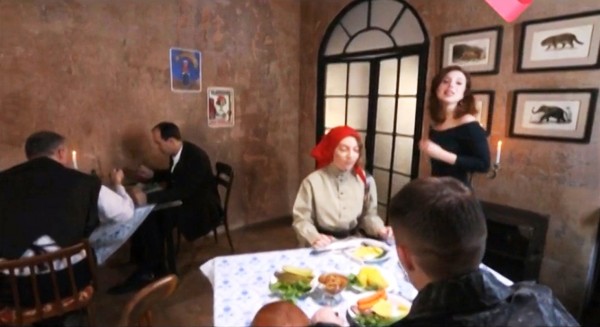
In Moscow, 1917-18, was restless. Shooting in the streets, arrests, fights. Often a dispute about the fate of Russia took place in taverns ( hehe, where were those taverns then? Matrosiki with revolvers quickly resolved all these disputes - P.Syutkina's comment ) and at the neighboring tables there could be well-to-do fists, Bolsheviks, peasants ... So often the gatherings ended in a banal scuffle.
No Bogomilova existed in nature. Yes, and imagine, the innkeeper in post-revolutionary times in 1918 is quite difficult. Funny scene fights in this institution was reconstructed on TV. Especially me as a historian, I was pleased with the TT pistol (issue of 1933) in the hand of the then gangster.

Bullies lick their wounds. On the face of a loss. That's just how to reconcile the ideological enemies and save the restaurant from ruin? It has dawned on the merchant Bogomilov: it is necessary to invent a “dish of peace”: a new, tasty, fatty one, and for political sense to have. Then the owner of the tavern entrusted his cook to invent such a dish. The cook has surpassed himself. The herring in its new salad symbolized the proletariat. Vegetables - the peasantry. The beet color reminded of the triumph of “red”, and the French invention “mayonnaise” was supposed to be a tasty morsel for hidden counterrevolutionaries. The novelty was called “SHUBA” - which, in its abbreviation, meant “Chauvinism and Decadence“ Boycott and Anathema ”.
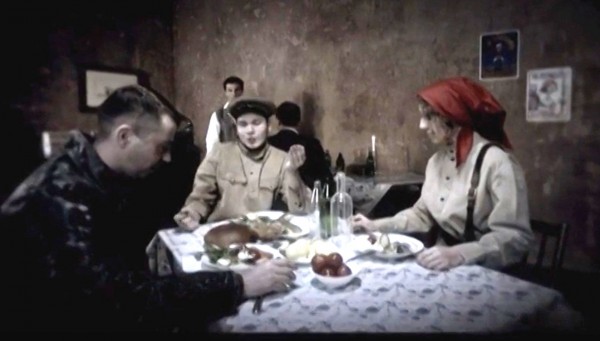
This is how little by little we expose this whole culinary myth. In fact, the recipe for "herring under a fur coat" appears in the Soviet culinary literature only in the late 1960s-1970s. Nothing of the kind — laid up in layers of potatoes, herring, mayonnaise, etc. — existed until now. Yes, some similar dishes with herring can be found at the end.XIX century, but they only remotely resemble this Soviet recipe. Which was the creative success of some of our housewives, who pleased her guests with a bold discovery. Sold out throughout the country.
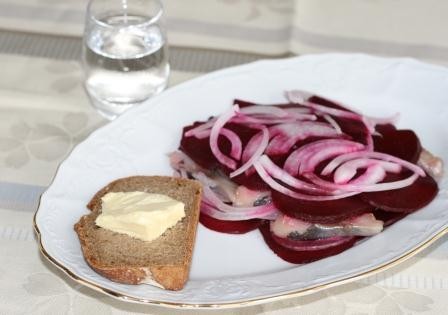
Herring "under the sheepskin coat" - variations on the theme
We are watching the “Second and Compote” program of the Moscow-Trust channel and are preparing together with Olga Syutkina:






